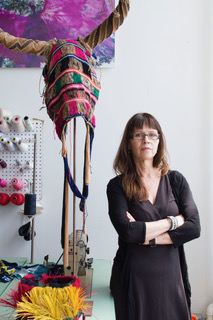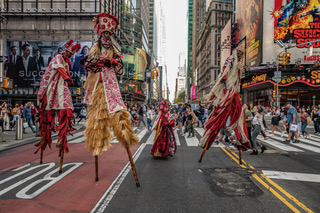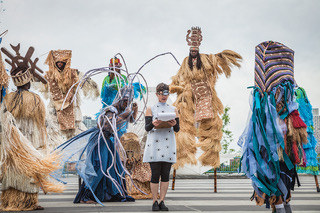Since 1992, Laura Anderson Barbata has initiated long-term projects and collaborative “interventions” in the Venezuelan Amazon, Trinidad and Tobago, Mexico, Norway, and the U.S. that address social justice and the environment. Her work often combines performance, procession, dance, music, spoken word, textile arts, costuming, papermaking, zines, and protest.
“It is my belief that a shared artistic and social practice can serve as a platform on which we connect, learn, exchange, create, and transcend borders, in order to activate our sense of belonging and responsibility towards each other,” says Anderson Barbata.
“My performance and ‘Intervention’ work seeks to further the expectations of socially engaged art by reclaiming public space and involving various collaborators such as librarians, scientists, activists, musicians, street dancers, and artisans to create works that operate both inside and outside of the art world.”
A Mexican transdisciplinary artist based in New York and Mexico City, Anderson Barbata teaches in the MIT Art, Culture and Technology program in Cambridge and is Honorary Fellow of the Latin American, Caribbean and Iberian Studies Program, University of Wisconsin, Madison. She is currently on the Board of Directors of the College Art Association where she also serves as VP for Diversity and Inclusion.
Her ongoing project “The Repatriation of Julia Pastrana,” begun in 2005, resulted in the removal of the indigenous Mexican performer’s body from the Schreiner Collection in Oslo and its successful repatriation and burial in Sinaloa, Mexico, Pastrana’s birth state. The project continues with upcoming publications, zines, exhibitions, and performances.
Anderson Barbata is also known for her project “Transcommunality” (2001–ongoing), working with stilt walkers, artists, and artisans from Mexico, New York, and the Caribbean. This project has been presented at various museums, schools, and other venues as exhibitions and ¨Interventions¨, among them the Museum of Modern Art, New York; the Modern Art Museum of Fort Worth, Texas; BRIC Arts | Media House, Brooklyn; Rutgers University; United Nations Plaza, New York; University of Wisconsin, Madison; Museo Textil de Oaxaca, México; Museo de la Ciudad de México; MUCA Roma, UNAM, Mexico City; the Isabella Stewart Gardner Museum and Newcomb Art Museum, New Orleans.
Her work is in various private and public collections including the Metropolitan Museum of Art, New York; el Museo de Arte Moderno, México D.F.; Landesbank Baden-Württemberg Gallery, Stuttgart, Germany; Fundación Cisneros; Museo Carrillo Gil, México; Museo Universitario Arte Contemporáneo MUAC, DGAV-UNAM. Mexico City; Museum of Contemporary Art, San Diego; Museum of Latin American Art MOLAA, Long Beach; USC Fisher Museum of Art; Museo Jaureguía, Navarra, Spain; Thyssen-Bornemisza Art Contemporary, among others.
Her work has been featured in numerous publications, including The New York Times, Sculpture Today (Phaidon Press), Kunstforum Germany, ARTnews, Art in America, ArtNexus, and 160 Años de Fotografía en México (INBA).
Anderson Barbata is a recipient of the Rockefeller Foundation Bellagio Center Artist in Residence, 2019; the Anonymous Was a Woman 2016 Award; Defense of Human Rights Award 2017 from the Instituto de Administración Pública de Tabasco, México; Honorary Fellow of LACIS (the Latin American, Caribbean, and Iberian Studies Program), University of Wisconsin, Madison; Fellow of the Thyssen-Bornemisza Art Contemporary TBA21 Academy; Miembro del Sistema Nacional de Creadores, México (2014-2017) and professor at the Escuela Nacional de Escultura, Pintura y Grabado La Esmeralda of the Instituto Nacional de Bellas Artes from 2010 until 2015.




